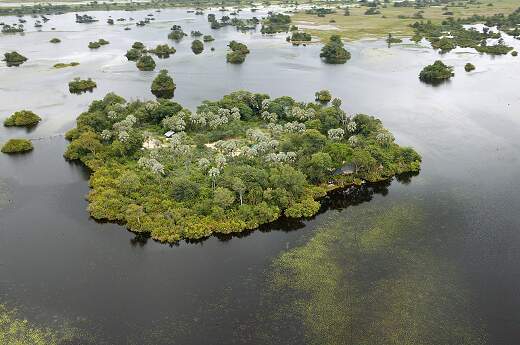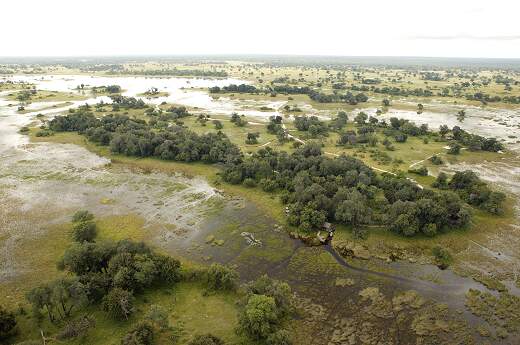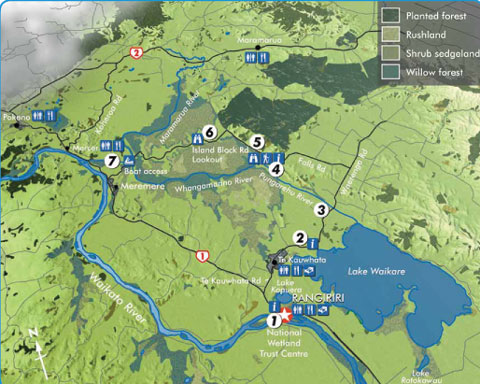![]()
Inundaciones, Zonas Húmedas y Cambio climático
Ya hemos hablado en otros post precedentes sobre los suelos de las zonas húmedas, estén o no permanentemente sumergidos bajo el agua. También escribimos en varias ocasiones acerca de las devastadoras consecuencias de las inundaciones. Sin embargo, cuando son estacionales, también tienen el efecto benéfico de fertilizar con nutrientes y sedimentos, los suelos de los deltas y tramos bajos de los cauces. Sobre ellos se edificaron grandes civilizaciones (como la de Egipto en el Nilo) y vive una considerable parte de la población mundial. Los humedales costeros parecen ser, además, defensas naturales que almacenan el agua sobrante de las inundaciones río abajo o río arriba (subida del nivel causado por huracanes y tsunamis). Al mismo tiempo, filtran los contaminantes dejando un agua más limpia. La superficie mundial de estos ecosistemas húmedos ha mermado considerablemente debido a su uso para la agricultura, turismo y piscifactorías, generando que los territorios aledaños sean más vulnerables frente a los desastres naturales comentados. Debe quedar bien claro que el vocablo “desastre natural” debiera siempre entenderse como perturbaciones de gran magnitud que afectan a los intereses humanos, ya que en muchas regiones del planeta los ecosistemas conviven y son efecto, de sus repercusiones.

Delta Okawango. Fuente: Eyes of Africa
Últimamente, se viene cuestionando si tales efectos benéficos pudieran tener una contrapartida negativa, por cuanto emiten considerables cantidades de metano a la atmósfera. Sin embargo, debemos recordar al mismo tiempo que estos ecosistemas secuestran también considerables cantidades de carbono. Tal debate se me antoja como un grave error de apreciación por cuanto, somos la especie humana la que ha incrementado alarmantemente las emisiones de este potente gas de invernadero al aire, mientras cada vez atesoramos menos humedales (y por lo tanto emiten menos a nivel global). ¿Porqué “cuestionamos su papel y no el nuestro? Los efectos benéficos mentados, “de ser ciertos” sobrarían para contrarrestar los presuntamente negativos, si tenemos en cuenta una gran multitud de factores. El 25 de Septiembre de 2008, los boletines de noticias Terradaily y Sciencedaily se hicieron eco de los resultados de un estudio que intentaba analizar el efecto de las inundaciones sobre las emisiones de gases por los humedales. La noticia llevaba por título: Flooding Might Help Lower Gas Emission From Wetlands. Es decir, las inundaciones disminuyen las emisiones de metano por los humedales. Personalmente, me pareció de lo más lógico. Y sobre este tema vamos ha redactar unas líneas hoy.

Delta Okawango. Fuente: Eyes of Africa
El agua encharcada y la materia orgánica que se acumula en los humedales, suele estar poco oxigenada cuando el ecosistema disfruta de una gran actividad biológica que lo consume. Bajo estas condiciones, que generalmente se producen en las estaciones más favorables para la vida), se generan pues ambientes anóxicos (deficientes en oxígeno disuelto) que dan lugar a una descomposición anaerobia de la materia orgánica, siendo esta la que libera el metano a la atmósfera. Generalmente, en estos ecosistemas, el nivel de las aguas fluctúa de acuerdo con el caudal de los ríos o fuentes que los alimenten (también pueden ser de origen freático). Cuando estos tienen crecidas el agua vuelve a oxigenarse, reduciendo las emisiones del susodicho gas. Pues bien, los investigadores que firman el estudio que ha dado lugar a la noticia que abajo exponemos en suahili, han emulado estas fluctuaciones de caudal artificialmente, mostrando que las riadas mayores son las que mejor actúan en este sentido. Obviamente, era de esperar que en el verano (del hemisferio norte) incremente la actividad biológica y las condiciones de carencia de oxígeno. No se trata de ningún descubrimiento espectacular. A falta de consultar otras fuentes, yo hubiera anticipado algo parecido. Lo mismo podría decirse respecto a que los bordes de las lagunas emitan más metano que las aguas más profundas, en donde con toda seguridad, sus sedimentos albergan menos materia orgánica, biomasa y actividad biológica (la noticia no habla de ello). En cualquier caso, resulta un tanto sorprendente que esta nota de prensa (desconozco si se ha tenido en cuenta en la publicación científica original) soslaye que si actualmente muchos humedales emiten más metano por no recibir “agua oxigenada” en grandes cantidades, se debe a que los embalses y represas que jalonan los grandes cauces fluviales lo impiden. Se trata de un efecto negativo de estas infraestructuras, no solo sobre las emisiones de los humedales, sino también de la fertilización que comentamos en el primer párrafo. Si deseamos emular a los ecosistemas deberíamos cambiar el modelo de ingeniería hidráulica que actualmente desplegamos sobre los sistemas superficiales terrestres. Posiblemente lo más interesante del estudio sean las cifras, pero no la sustancia.

Humedales e Inundaciones Información satelital
De todos los modos, el estudio viene bien con vistas a enfatizar ciertos aspectos de las inundaciones. Si actualmente hacen tanto daño a la humanidad no es por su dinámica intrínseca, sino porque generamos infraestructuras e incrementamos la densidad de población en áreas que naturalmente sufren perturbaciones periódicas frecuentes del tipo de los huracanes, tsunamis, inundaciones, etc. Justamente los humedales parece que ayudan a paliar sus efectos, pero al eliminarlas, los habitantes de estas áreas podrían quedar más expuestos a sus devastadores efectos. Antaño los nativos que allí vivían entendían mejor las fuerzas de la naturaleza y no osaban intentar burlarlas. Hoy no es así y pagamos las consecuencias de nuestra arrogancia. Os dejo ya con la noticia para los amantes de las cifras, no sin antes señalar que algunos expertos no tienen tan claros el efecto tampón de los humedales litorales, como ya analizaremos en otros post. .
Juan José Ibáñez
Flooding Might Help Lower Gas Emission From Wetlands
by Staff Writers;
River floods and storms that send water surging through swamps and marshes near rivers and coastal areas might cut in half the average greenhouse gas emissions from those affected wetlands, according to recent research at Ohio State University.
The average levels of methane emissions in the deepest water of the wetlands over the course of the study were 6 pounds of carbon per day in the pulsing year and almost 12 pounds of carbon per day during the steady-flow year A study suggests that pulses of water through wetlands result in lower average emissions of greenhouse gases over the course of the year compared to the emissions from wetlands that receive a steady flow of water.
The study compared the emission of methane from wetlands under two different conditions, one with a pulsing hydrology system designed to resemble river flooding and one with a steady, low flow of water. The research showed that in areas of deeper water within the wetlands, methane gas fluxes were about twice as high in steady-flow systems than they were in pulsing systems. Methane emissions from edge zones, which are sometimes dry, were less affected by the different types of conditions. Methane is the major component of natural gas and is a greenhouse gas associated with global warming. While the Environmental Protection Agency estimates that human activities are responsible for about 60 percent of methane emissions worldwide, wetlands are among the natural sources. Bacteria that produce methane during the decay of organic material cause wetlands to release the gas into the atmosphere.
The study by
The study examined methane fluxes over a two-year period during which researchers created two different kinds of conditions in two 2.5-acre experimental wetlands. In 2004, scientists used pumps to deliver monthly pulses to create conditions in the wetlands resembling natural marshes flooded with river water. In 2005, researchers pumped approximately the same amount of water but maintained a constant flow of water through the wetlands to mimic less dynamic hydrologic conditions. In addition to methane emissions, the study also investigated other processes such as denitrification, sedimentation, and aquatic productivity.
The pulsing hydrology experiment was maintained and methane levels were measured approximately twice monthly over the two study years (…). During both years, more methane was emitted during the summer than during other seasons in all portions of the wetlands, with emissions about four times higher during summer in the edge zones. Consistently wet areas released more gases in the spring than did edge zones under both conditions.
(…). The emissions were at their highest during the summer of the steady-flow year, when the amount of methane released from the deepest part of the wetlands averaged 18.5 milligrams of carbon per square meter of wetland surface per hour. With these wetlands covering about 5 acres, the emissions amounted to an estimated 20 pounds of carbon per day. That level was twice as high as the summertime methane emissions measured from the deepest area of the wetlands during the year of pulsing conditions.
The average levels of methane emissions in the deepest water of the wetlands over the course of the study were 6 pounds of carbon per day in the pulsing year and almost 12 pounds of carbon per day during the steady-flow year. The researchers suggested that slightly warmer soil temperatures and less fluctuation in water levels during the steady-flow year created conditions that promoted the production of methane. A simultaneous study of carbon collection in the wetlands showed that the different water conditions had no significant effect on how much carbon was stored by the wetlands. Many experts suggest that the benefits of wetlands’ carbon storage capacity offset any damage resulting from their methane emissions.
Mitsch noted that pulses from storms not only help dissipate one negative effect of wetlands, but also serve as a reminder of how wetlands function to absorb the surge. «If we didn’t have salt marshes and mangroves in subtropical and tropical coastal areas of the

[…] los humedades (naturales y artificiales), por lo que hoy no abundaremos en el tema, y menos aún en su relación con el cambio climático, como harían otros muchos colegas. En este post damos cuenta de una nota de prensa aparecida el […]